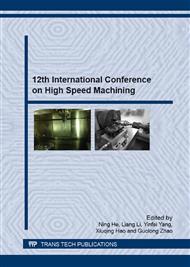[1]
C. Chen, W. Zhao, N. He, L. Li, Y.F. Yang. Experimental Study on High Feed Milling of TC4 Ti-Alloy in Liquid Nitrogen Cooling. Tool Engineering, 8 (2014) 13-17.
Google Scholar
[2]
W. Zhao, N. He, L. Li. Investigation on Chip Formation in High Speed Cutting of TI6AL4V Alloy with Nitrogen Gas. GuangZhou: The 7th International Conference on Frontiers of Design and Manufacturing, (2006).
Google Scholar
[3]
H.T. Liu, Y.Z. Sun, Y.Q. Geng, D.B. Shan. Experimental Research of Milling Force and Surface Quality for TC4 Titanium Alloy of Micromilling. The International Journal of Advanced Manufacturing Technology, 79 (2015) 705-716.
DOI: 10.1007/s00170-015-6844-5
Google Scholar
[4]
M. Stanford, P.M. Lister, C. Morgan, K.A. Kibble. Investigation into the Use of Gaseous and Liquid Nitrogen as a Cutting Fluid When Turning BS 970-80A15 (En32b) Plain Carbon Steel Using WC-Co Uncoated Tooling. Journal of Materials Processing Technology, 209 (2009).
DOI: 10.1016/j.jmatprotec.2008.03.003
Google Scholar
[5]
V.P. Astakhov, S.V. Shvets, M.O.M. Osman. Chip Structure Classification Based on Mechanics of Its Formation. Journal of Materials Processing Technology, 74 (1997) 247-257.
DOI: 10.1016/s0924-0136(97)00081-2
Google Scholar
[6]
D.P.F.C. Jaspers, J.H. Dautzenberg. Material Behavior in Metal Cutting: Strains, Strain Rates and Temperatures in Chip Formation. Journal of Materials Processing Technology, 121 (2002) 123-135.
DOI: 10.1016/s0924-0136(01)01227-4
Google Scholar
[7]
T.C. Yap, N.S.M. El-Tayeb, P.V. Brevern. Cutting Forces, Friction Coefficient And Surface Roughness in Machining Ti-5Al-4V-0. 6Mo-0. 4Fe Using Carbide Tool K313 under Low Pressure Liquid Nitrogen. Journal of the Brazilian Society of Mechanical Sciences and Engineering, 35 (2013).
DOI: 10.1007/s40430-013-0001-6
Google Scholar
[8]
M. Stanford, P.M. Lister, K.A. Kibble, C. Morgan, T. Sihra. Tool Wear Investigation Whilst Turning BS970-080A15 Carbon Steel Using TiCN-Al2O3 CVD Coated Carbide Tooling in Gaseous And Liquid Nitrogen Environments. Industrial Lubrication and Tribology, 65 (2013).
DOI: 10.1108/00368791311331211
Google Scholar


